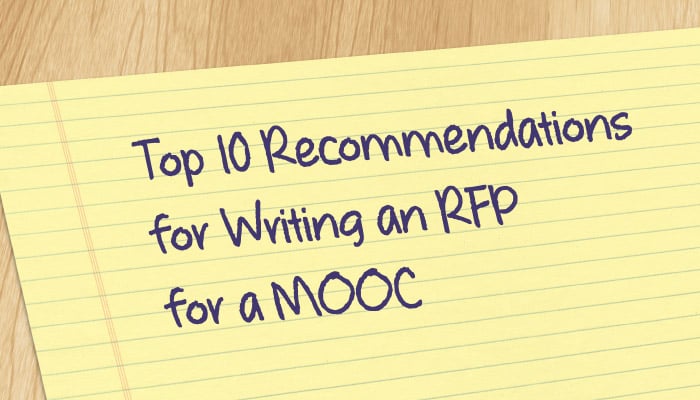At ExtensionEngine, we see lots of RFPs. MOOCs (and online classes, generally) are what we do, so we thought a few guidelines would help these organizations put together an RFP that covers what needs to be covered. Here are our top 10 recommendations …for writing an RFP for a MOOC.
- Describe Target Learners: Who are your target learners? While it is tempting to say, “college students,” “20K employees” or “any adult learner”, the ideal approach is to provide a detailed segmentation of your target audience of learners and their respective profiles. What is their existing knowledge? What do they hope to achieve by taking the course? How much time do they have to spend on it? How comfortable are they with technology generally and online learning specifically? What language(s) will the course materials and participants use? What preparation do students need to have? Why might they be interested, and how might they have become interested in this topic?
- Learning Objectives: Describe what you hope the learner will be able to do and/or demonstrate by the end of the class. You do not need a complete analysis here, but you should have a pretty good idea about your expectations for what they will learn. Do they need to pass a certification test? Create a wood sculpture using just a butter knife? Put together a Kickstarter campaign for a healthcare invention? Clarity about this point will go a long way in making the online experience a great one for students.
- Business Model: Do you hope to make money off of your course? If not, how is it sustainable? Where will the enrollees come from? Why will they be attracted to the course? How does this course fit into a scalable strategy for future courses? Who are the major stakeholders within your organization?
- Evaluate Your Content: This is where the work load begins to take shape. How much of the course material needs to be converted and how much created from scratch? Do you see a student needing 14 weeks, 2 days, or something in-between to complete the course? What’s the quality of the videos that you want created, and can you point to an example that you want emulated? Is it your content or are you licensing it from a 3rd party? What is the process for review and sign-off of the new content?
- Your Pedagogical Model: What is the overall experience you want to create for your learners? Will the course be online only or “blended” with live classes, meetups, or other events? Are you looking for a lot of interaction with the professor? A lot of interaction among students? Do you want the path through the course to be the same for each learner or do you want adaptive or personalization approaches applied? What is the assessment strategy for how learners demonstrate their mastery of the learning objectives? You may not have an answer to all of these questions, and you may end up changing your mind during the design process, but these are some of the questions you will discuss with the instructional designers early in the overall process.
- Technology Environment: Online courses take place on a Web-based platform and within a specific set of technologies. Has your organization committed to an LMS? Are you open to adopting a new platform, and if so, how do you want the systems integrated? Do you foresee students interacting with the course on the Web, tablets, and mobile phones? Will students be global or local? What type of communications infrastructure (Wifi, LTE, etc.) can be assumed? What internal tools and systems does your organization already have in place that would affect this course? For example, has your organization adopted a user authentication platform? Have you committed to specific standards (e.g., LTI)?
- Measurement: How do you plan to measure and test the course's effectiveness? How will you detect how participants react to the course? How will you tell if participants are acquiring the intended knowledge, skills, attitudes, confidence and/or commitment based on their participation? How will you determine if they know how to apply --- and actually do apply --- the skills and knowledge they learned during the course? How will you determine if these targeted outcomes are occurring as a result of the course? Also, what type of data analytics do you expect out of the course? What are your course and/or student metrics for success? Do you want these available to students during the course? Do you plan to measure the business impact of the course? If so, how? (This is hard to do correctly!)
- Ongoing Support Requirements: Online courses have a need for ongoing support. What resources will your organization be willing to devote to course operations? What level of support (e.g., 24x7, average response time, etc.) will your students require when taking the course? Similarly for the teachers --- what level of support will they require? Is your organization equipped to host and maintain an instance of the course or do you require the vendor to do this?
- Current Team: What resources does your organization have to commit to this course? Do the members of your team have prior experience building online courses? Do you have an internal team of developers? Do you have all the subject matter experts on your payroll? Do you have additional vendors you want included on the project? What would their role be? Who is ultimately responsible for final decisions and sign-off? Ultimately you want to decide if you need the vendor to “just do the job” or to “train the trainers” while doing the job.
- Timing: When do you want the course to be live? Will this be a pilot? How do you foresee this course being used after the initial rollout? Do you foresee a need to update it frequently?
The above ten points describe what an organization should include when writing an RFP for a MOOC. Not only will thinking about these questions help vendors put together more accurate and useful proposals, but they will also help you and your organization prepare for the class.


